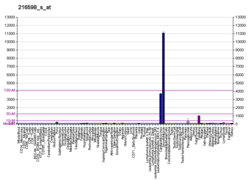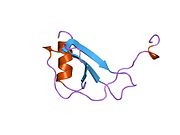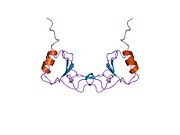The chemokine (C-C motif) ligand 2 (CCL2) is also referred to as monocyte chemoattractant protein 1 (MCP1) and small inducible cytokine A2. CCL2 is a small cytokine that belongs to the CC chemokine family. CCL2 tightly regulates cellular mechanics and thereby recruits monocytes, memory T cells, and dendritic cells to the sites of inflammation produced by either tissue injury or infection.
Genomics
In the human genome, CCL2 and many other CC chemokines are located on chromosome 17 (17q11.2-q21.1). The gene span is 1,927 bases and the CCL2 gene resides on the Watson (plus) strand. The CCL2 gene has three exons and two introns. The CCL2 protein precursor contains a signal peptide of 23 amino acids. In turn, the mature CCL2 is 76 amino acids long. The CCL2 predicted weight is 11.025 kilodaltons (kDa).
Population genetics
In humans, the levels of CCL2 can vary considerably. In the white people of European descent, the multivariable-adjusted heritability of CCL2 concentrations is as much as 0.37 in the blood plasma and 0.44 - in the serum.
Molecular biology
CCL2 is a monomeric polypeptide, with a molecular weight of approximately 13-15 kDa depending on levels of glycosylation. CCL2 is anchored in the plasma membrane of endothelial cells by glycosaminoglycan side chains of proteoglycans. CCL2 is primarily secreted by monocytes, macrophages and dendritic cells. Platelet derived growth factor is a major inducer of CCL2 gene.
CCR2 and CCR4 are two cell surface receptors that bind CCL2.
CCL2 exhibits a chemotactic activity for monocytes and basophils. However, it does not attract neutrophils or eosinophils. After deletion of the N-terminal residue, CCL2 loses its attractivity for basophils and becomes a chemoattractant of eosinophils. Basophils and mast cells that are treated with CCL2 release their granules to the intercellular space. This effect can be also potentiated by a pre-treatment with IL-3 or even by other cytokines. CCL2 augments monocyte anti-tumor activity and it is essential for formation of granulomas. CCL2 protein become a CCR2 antagonist when it is cleaved by metalloproteinase MMP-12.
CCL2 can be found at the sites of tooth eruption and bone degradation. In the bone, CCL2 is expressed by mature osteoclasts and osteoblasts and it is under control of nuclear factor κB (NFκB). In the human osteoclasts, CCL2 and RANTES (regulated on activation normal T cell expressed and secreted). Both MCP-1 and RANTES induce formation of TRAP-positive, multinuclear cells from M-CSF-treated monocytes in the absence of RANKL, but produced osteoclasts that lacked cathepsin K expression and resorptive capacity. It is proposed that CCL2 and RANTES act as autocrine loop in human osteoclast differentiation.
The CCL2 chemokine is also expressed by neurons, astrocytes and microglia. The expression of CCL2 in neurons is mainly found in the cerebral cortex, globus pallidus, hippocampus, paraventricular and supraoptic hypothalamic nuclei, lateral hypothalamus, substantia nigra, facial nuclei, motor and spinal trigeminal nuclei, gigantocellular reticular nucleus and in Purkinje cells in the cerebellum.
Clinical importance
CCL2 is implicated in pathogeneses of several diseases characterized by monocytic infiltrates, such as psoriasis, rheumatoid arthritis and atherosclerosis.
Administration of anti-CCL2 antibodies in a model of glomerulonephritis reduces infiltration of macrophages and T cells, reduces crescent formation, as well as scarring and renal impairment.
CCL2 is involved in the neuroinflammatory processes that takes place in the various diseases of the central nervous system (CNS), which are characterized by neuronal degeneration. CCL2 expression in glial cells is increased in epilepsy, brain ischemia Alzheimer's disease experimental autoimmune encephalomyelitis (EAE), and traumatic brain injury.
Hypomethylation of CpG sites within the CCL2 promoter region is affected by high levels of blood glucose and TG, which increase CCL2 levels in the blood serum. The later plays an important role in the vascular complications of type 2 diabetes.
CCL2 induces amylin expression through ERK1/ERK2/JNK-AP1 and NF-κB related signaling pathways independent of CCR2. Amylin upregulation by CCL2 contributes to the elevation of the plasma amylin and insulin resistance in obesity.
Adipocytes secrete various adipokines that may be involved in the negative cross-talk between adipose tissue and skeletal muscle. CCL2 impairs insulin signaling in skeletal muscle cells via ERK1/2 activation at doses similar to its physiological plasma concentrations (200 pg/mL), but does not involve activation of the NF-κB pathway. CCL2 significantly reduced insulin-stimulated glucose uptake in myocytes. CCL2 may represent a molecular link in the negative cross-talk between adipose tissue and skeletal muscle assigning a completely novel important role to CCL2 besides inflammation.
Incubation of HL-1 cardiomyocytes and human myocytes with oxidized-LDL induced the expression of BNP and CCL2 genes, while native LDL (N-LDL) had no effect.
Treatment with melatonin in old mice with age related liver inflammation decreased the mRNA expression of TNF-α, IL-1β, HO (HO-1 and HO-2), iNOS, CCL2, NF-κB1, NF-κB2 and NKAP in old male mice. The protein expression of TNF-α, IL-1β was also decreased and IL-10 increased with melatonin treatment. Exogenous administration of melatonin was able to reduce inflammation.
References
- ^ GRCh38: Ensembl release 89: ENSG00000108691 – Ensembl, May 2017
- ^ GRCm38: Ensembl release 89: ENSMUSG00000035352 – Ensembl, May 2017
- "Human PubMed Reference:". National Center for Biotechnology Information, U.S. National Library of Medicine.
- "Mouse PubMed Reference:". National Center for Biotechnology Information, U.S. National Library of Medicine.
- Evers TM, Sheikhhassani V, Haks MC, Storm C, Ottenhoff TH, Mashaghi A (January 2022). "Single-cell analysis reveals chemokine-mediated differential regulation of monocyte mechanics". iScience. 25 (1): 103555. Bibcode:2022iSci...25j3555E. doi:10.1016/j.isci.2021.103555. PMC 8693412. PMID 34988399.
- Carr MW, Roth SJ, Luther E, Rose SS, Springer TA (April 1994). "Monocyte chemoattractant protein 1 acts as a T-lymphocyte chemoattractant". Proceedings of the National Academy of Sciences of the United States of America. 91 (9): 3652–6. Bibcode:1994PNAS...91.3652C. doi:10.1073/pnas.91.9.3652. PMC 43639. PMID 8170963.
- Xu LL, Warren MK, Rose WL, Gong W, Wang JM (September 1996). "Human recombinant monocyte chemotactic protein and other C-C chemokines bind and induce directional migration of dendritic cells in vitro". Journal of Leukocyte Biology. 60 (3): 365–71. doi:10.1002/jlb.60.3.365. PMID 8830793. S2CID 24481789.
- Mehrabian M, Sparkes RS, Mohandas T, Fogelman AM, Lusis AJ (January 1991). "Localization of monocyte chemotactic protein-1 gene (SCYA2) to human chromosome 17q11.2-q21.1". Genomics. 9 (1): 200–3. doi:10.1016/0888-7543(91)90239-B. PMID 2004761.
- Yoshimura T, Yuhki N, Moore SK, Appella E, Lerman MI, Leonard EJ (February 1989). "Human monocyte chemoattractant protein-1 (MCP-1). Full-length cDNA cloning, expression in mitogen-stimulated blood mononuclear leukocytes, and sequence similarity to mouse competence gene JE". FEBS Letters. 244 (2): 487–93. Bibcode:1989FEBSL.244..487Y. doi:10.1016/0014-5793(89)80590-3. PMID 2465924. S2CID 7097272.
- Furutani Y, Nomura H, Notake M, Oyamada Y, Fukui T, Yamada M, Larsen CG, Oppenheim JJ, Matsushima K (February 1989). "Cloning and sequencing of the cDNA for human monocyte chemotactic and activating factor (MCAF)". Biochemical and Biophysical Research Communications. 159 (1): 249–55. doi:10.1016/0006-291X(89)92430-3. PMID 2923622.
- McDermott DH, Yang Q, Kathiresan S, Cupples LA, Massaro JM, Keaney JF, Larson MG, Vasan RS, Hirschhorn JN, O'Donnell CJ, Murphy PM, Benjamin EJ (August 2005). "CCL2 polymorphisms are associated with serum monocyte chemoattractant protein-1 levels and myocardial infarction in the Framingham Heart Study". Circulation. 112 (8): 1113–20. doi:10.1161/CIRCULATIONAHA.105.543579. PMID 16116069. S2CID 12320863.
- Bielinski SJ, Pankow JS, Miller MB, Hopkins PN, Eckfeldt JH, Hixson J, Liu Y, Register T, Myers RH, Arnett DK (December 2007). "Circulating MCP-1 levels shows linkage to chemokine receptor gene cluster on chromosome 3: the NHLBI family heart study follow-up examination". Genes and Immunity. 8 (8): 684–90. doi:10.1038/sj.gene.6364434. PMID 17917677. S2CID 8242432.
- Yoshimura T (April 2018). "The chemokine MCP-1 (CCL2) in the host interaction with cancer: a foe or ally?". Cellular & Molecular Immunology. 15 (4): 335–345. doi:10.1038/cmi.2017.135. PMC 6052833. PMID 29375123.
- Craig MJ, Loberg RD (December 2006). "CCL2 (Monocyte Chemoattractant Protein-1) in cancer bone metastases". Cancer and Metastasis Reviews. 25 (4): 611–9. doi:10.1007/s10555-006-9027-x. PMID 17160712. S2CID 24366011.
- Conti P, Boucher W, Letourneau R, Feliciani C, Reale M, Barbacane RC, Vlagopoulos P, Bruneau G, Thibault J, Theoharides TC (November 1995). "Monocyte chemotactic protein-1 provokes mast cell aggregation and [3H]5HT release". Immunology. 86 (3): 434–40. PMC 1383948. PMID 8550082.
- Bischoff SC, Krieger M, Brunner T, Dahinden CA (May 1992). "Monocyte chemotactic protein 1 is a potent activator of human basophils". The Journal of Experimental Medicine. 175 (5): 1271–5. doi:10.1084/jem.175.5.1271. PMC 2119199. PMID 1569397.
- Dean RA, Cox JH, Bellac CL, Doucet A, Starr AE, Overall CM (October 2008). "Macrophage-specific metalloelastase (MMP-12) truncates and inactivates ELR+ CXC chemokines and generates CCL2, -7, -8, and -13 antagonists: potential role of the macrophage in terminating polymorphonuclear leukocyte influx". Blood. 112 (8): 3455–64. doi:10.1182/blood-2007-12-129080. PMID 18660381. S2CID 25944573.
- Kim MS, Day CJ, Morrison NA (April 2005). "MCP-1 is induced by receptor activator of nuclear factor-κB ligand, promotes human osteoclast fusion, and rescues granulocyte macrophage colony-stimulating factor suppression of osteoclast formation". The Journal of Biological Chemistry. 280 (16): 16163–9. doi:10.1074/jbc.M412713200. PMID 15722361. S2CID 22756184.
- Banisadr G, Gosselin RD, Mechighel P, Kitabgi P, Rostène W, Parsadaniantz SM (August 2005). "Highly regionalized neuronal expression of monocyte chemoattractant protein-1 (MCP-1/CCL2) in rat brain: evidence for its colocalization with neurotransmitters and neuropeptides". The Journal of Comparative Neurology. 489 (3): 275–92. doi:10.1002/cne.20598. PMID 16025454. S2CID 22254007.
- Xia M, Sui Z (March 2009). "Recent developments in CCR2 antagonists". Expert Opinion on Therapeutic Patents. 19 (3): 295–303. doi:10.1517/13543770902755129. PMID 19441905. S2CID 45028620.
- Lloyd CM, Minto AW, Dorf ME, Proudfoot A, Wells TN, Salant DJ, Gutierrez-Ramos JC (April 1997). "RANTES and monocyte chemoattractant protein-1 (MCP-1) play an important role in the inflammatory phase of crescentic nephritis, but only MCP-1 is involved in crescent formation and interstitial fibrosis". The Journal of Experimental Medicine. 185 (7): 1371–80. doi:10.1084/jem.185.7.1371. PMC 2196251. PMID 9104823.
- Gerard C, Rollins BJ (February 2001). "Chemokines and disease". Nature Immunology. 2 (2): 108–15. doi:10.1038/84209. PMID 11175802. S2CID 28336866.
- Foresti ML, Arisi GM, Katki K, Montañez A, Sanchez RM, Shapiro LA (December 2009). "Chemokine CCL2 and its receptor CCR2 are increased in the hippocampus following pilocarpine-induced status epilepticus". Journal of Neuroinflammation. 6: 40. doi:10.1186/1742-2094-6-40. PMC 2804573. PMID 20034406.
- Fabene PF, Bramanti P, Constantin G (July 2010). "The emerging role for chemokines in epilepsy". Journal of Neuroimmunology. 224 (1–2): 22–7. doi:10.1016/j.jneuroim.2010.05.016. PMID 20542576. S2CID 5121343.
- Kim JS, Gautam SC, Chopp M, Zaloga C, Jones ML, Ward PA, Welch KM (February 1995). "Expression of monocyte chemoattractant protein-1 and macrophage inflammatory protein-1 after focal cerebral ischemia in the rat". Journal of Neuroimmunology. 56 (2): 127–34. doi:10.1016/0165-5728(94)00138-e. PMID 7860708. S2CID 45538922.
- Hickman SE, El Khoury J (April 2010). "Mechanisms of mononuclear phagocyte recruitment in Alzheimer's disease". CNS & Neurological Disorders Drug Targets. 9 (2): 168–73. doi:10.2174/187152710791011982. PMC 3684802. PMID 20205643.
- Ransohoff RM, Hamilton TA, Tani M, Stoler MH, Shick HE, Major JA, Estes ML, Thomas DM, Tuohy VK (April 1993). "Astrocyte expression of mRNA encoding cytokines IP-10 and JE/MCP-1 in experimental autoimmune encephalomyelitis". FASEB Journal. 7 (6): 592–600. doi:10.1096/fasebj.7.6.8472896. PMID 8472896. S2CID 13552110.
- Semple BD, Bye N, Rancan M, Ziebell JM, Morganti-Kossmann MC (April 2010). "Role of CCL2 (MCP-1) in traumatic brain injury (TBI): evidence from severe TBI patients and CCL2-/- mice". Journal of Cerebral Blood Flow and Metabolism. 30 (4): 769–82. doi:10.1038/jcbfm.2009.262. PMC 2949175. PMID 20029451.
- Liu ZH, Chen LL, Deng XL, Song HJ, Liao YF, Zeng TS, Zheng J, Li HQ (June 2012). "Methylation status of CpG sites in the MCP-1 promoter is correlated to serum MCP-1 in Type 2 diabetes". Journal of Endocrinological Investigation. 35 (6): 585–9. doi:10.3275/7981. PMID 21975431. S2CID 14613351.
- Cai K, Qi D, Hou X, Wang O, Chen J, Deng B, Qian L, Liu X, Le Y (May 2011). Fadini GP (ed.). "MCP-1 upregulates amylin expression in murine pancreatic β cells through ERK/JNK-AP1 and NF-κB related signaling pathways independent of CCR2". PLOS ONE. 6 (5): e19559. Bibcode:2011PLoSO...619559C. doi:10.1371/journal.pone.0019559. PMC 3092759. PMID 21589925.
- Sell H, Dietze-Schroeder D, Kaiser U, Eckel J (May 2006). "Monocyte chemotactic protein-1 is a potential player in the negative cross-talk between adipose tissue and skeletal muscle". Endocrinology. 147 (5): 2458–67. doi:10.1210/en.2005-0969. PMID 16439461.
- Chandrakala AN, Sukul D, Selvarajan K, Sai-Sudhakar C, Sun B, Parthasarathy S (January 2012). "Induction of brain natriuretic peptide and monocyte chemotactic protein-1 gene expression by oxidized low-density lipoprotein: relevance to ischemic heart failure". American Journal of Physiology. Cell Physiology. 302 (1): C165-77. doi:10.1152/ajpcell.00116.2011. PMID 21900689. S2CID 9801961.
- Cuesta S, Kireev R, Forman K, García C, Escames G, Ariznavarreta C, Vara E, Tresguerres JA (December 2010). "Melatonin improves inflammation processes in liver of senescence-accelerated prone male mice (SAMP8)". Experimental Gerontology. 45 (12): 950–6. doi:10.1016/j.exger.2010.08.016. PMID 20817086. S2CID 42491323.
External links
- Human CCL2 genome location and CCL2 gene details page in the UCSC Genome Browser.
Further reading
- Yoshimura T, Leonard EJ (1991). "Human Monocyte Chemoattractant Protein-1 (MCP-1)". Chemotactic Cytokines. Advances in Experimental Medicine and Biology. Vol. 305. pp. 47–56. doi:10.1007/978-1-4684-6009-4_6. ISBN 978-1-4684-6011-7. PMID 1661560.
- Wahl SM, Greenwell-Wild T, Hale-Donze H, Moutsopoulos N, Orenstein JM (September 2000). "Permissive factors for HIV-1 infection of macrophages". Journal of Leukocyte Biology. 68 (3): 303–10. doi:10.1189/jlb.68.3.303. PMID 10985244. S2CID 41684404.
- Sell H, Eckel J (June 2007). "Monocyte chemotactic protein-1 and its role in insulin resistance". Current Opinion in Lipidology. 18 (3): 258–62. doi:10.1097/MOL.0b013e3281338546. PMID 17495598. S2CID 33827660.
| PDB gallery | |
|---|---|
|
| Cell signaling: cytokines | |||||||||||||||||||||||||||||||||||||||||||
|---|---|---|---|---|---|---|---|---|---|---|---|---|---|---|---|---|---|---|---|---|---|---|---|---|---|---|---|---|---|---|---|---|---|---|---|---|---|---|---|---|---|---|---|
| By family |
| ||||||||||||||||||||||||||||||||||||||||||
| By function/ cell | |||||||||||||||||||||||||||||||||||||||||||
| Chemokine receptor modulators | |||||||||||||||||||||||||
|---|---|---|---|---|---|---|---|---|---|---|---|---|---|---|---|---|---|---|---|---|---|---|---|---|---|
| CC |
| ||||||||||||||||||||||||
| CXC |
| ||||||||||||||||||||||||
| C (XC) |
| ||||||||||||||||||||||||
| CX3C |
| ||||||||||||||||||||||||
| Others |
| ||||||||||||||||||||||||











